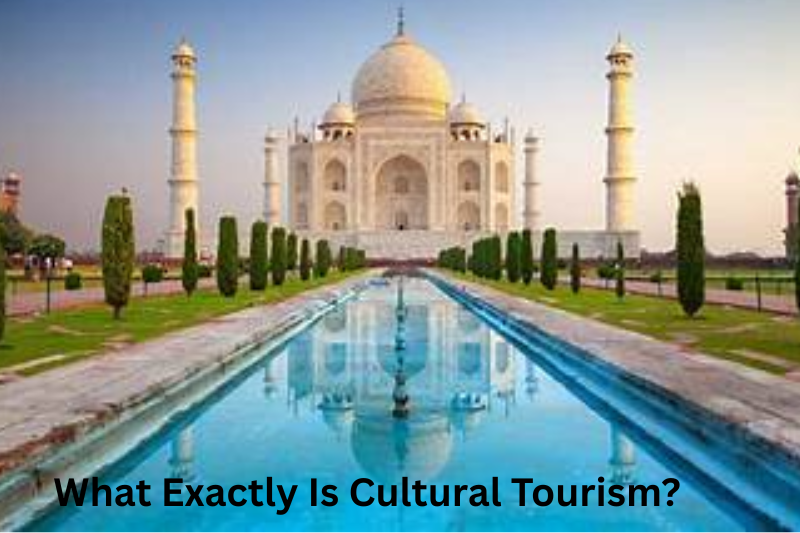Travel is often seen as an escape — a break from the routine, a chance to explore new sights, taste new foods, and relax. But beyond sightseeing and leisure lies a deeper, more meaningful kind of travel: cultural tourism experiences.
This type of travel goes beyond simply visiting a place; it’s about living its culture, engaging with its people, and understanding its traditions. Whether it’s joining a traditional dance workshop in Bali, exploring ancient ruins in Mexico, or staying with a local family in Greece, cultural tourism turns travel into a rich exchange of ideas and experiences.
What Exactly Is Cultural Tourism?

Cultural tourism is a form of travel focused on experiencing and learning about the culture, heritage, and lifestyle of a destination. It includes visiting museums, historic sites, festivals, or art galleries — but it also extends to smaller, more intimate moments, like tasting local dishes, participating in traditional ceremonies, or simply talking to local people about their way of life.
The key difference between cultural tourism and regular tourism is depth. While traditional tourists may take photos of a monument, cultural tourists want to understand its story, the people who built it, and its place in local identity.
Types of Cultural Tourism Experiences
Cultural tourism can take many forms, depending on what interests you most. Some of the most popular include:
1. Heritage Tourism
Visiting ancient temples, castles, or monuments to connect with a place’s history. Examples include the Pyramids of Egypt, Machu Picchu in Peru, or the Great Wall of China.
2. Arts and Performance Tourism
Attending music festivals, theatre performances, or traditional dance events to witness the creativity and talent that define a culture.
3. Culinary Tourism
Exploring a country through its food. Think of wine tasting in France, street food tours in Thailand, or traditional cooking classes in Italy.
4. Community-Based Tourism
Staying in small villages, participating in daily routines, and learning from locals. This is one of the most authentic ways to engage in cultural tourism.
5. Spiritual and Religious Tourism
Visiting sacred places such as temples, mosques, or churches — not just for worship, but to understand spiritual traditions and beliefs that shape societies.
Examples of Memorable Cultural Tourism Experiences
- Learning Calligraphy in Japan:
Discovering the beauty and discipline behind this centuries-old art form teaches more than technique—it reveals values of patience and mindfulness. - Participating in India’s Holi Festival:
Celebrating color, joy, and renewal alongside locals gives travelers a vibrant window into India’s cultural and spiritual life. - Exploring the Streets of Havana, Cuba:
Listening to live salsa music, admiring colonial architecture, and talking with residents about their history make for a truly immersive journey. - Visiting Indigenous Communities in Canada:
Travelers can learn about traditional crafts, ecological wisdom, and storytelling passed down for generations.
Each of these experiences goes beyond entertainment; they educate, inspire, and connect people from different worlds.
Benefits of Cultural Tourism Experiences
Cultural tourism offers a range of personal, social, and economic benefits — for both travelers and local communities.
1. Personal Enrichment
Cultural tourism expands your worldview. By seeing how other people live, work, and celebrate, you gain empathy, tolerance, and appreciation for diversity.
2. Authentic Experiences
Unlike typical tourism, cultural travel offers genuine interaction with local life. You don’t just watch — you participate, which creates meaningful memories.
3. Economic Development
When travelers support local artisans, guides, and family-run businesses, it helps generate income for small communities, especially in rural or developing areas.
4. Preservation of Heritage
Tourism can play a vital role in protecting cultural heritage. By visiting historical sites and supporting traditional crafts, travelers help maintain and fund preservation efforts.
5. Education and Awareness
Cultural tourism helps travelers understand global issues such as colonial history, indigenous rights, and cultural sustainability. It turns travel into a form of informal education.
You may also like to read these posts:
Travel Safety Tips 2026: A Complete Guide to Safe and Smart Traveling
Money Saving Travel Tips: How to Travel More While Spending Less
International Travel Tips Guide: Everything You Need to Know Before Traveling Abroad
Travel Tips for Families: A Complete Guide to Stress-Free and Enjoyable Adventures
Drawbacks and Challenges of Cultural Tourism

While cultural tourism has many positives, it also comes with certain challenges that travelers and destinations should be mindful of.
1. Cultural Exploitation
Sometimes, traditions are commercialized or exaggerated for tourists, losing their original meaning and authenticity.
2. Overtourism
When too many visitors flock to the same cultural sites, it can cause environmental damage, overcrowding, and strain on local communities.
3. Cultural Misunderstanding
If travelers don’t respect local customs or dress codes, it can lead to offense or cultural tension.
4. Economic Inequality
Not all community members may benefit equally from tourism income — sometimes only large tour operators or foreign companies profit.
5. Loss of Privacy and Identity
In some places, constant exposure to tourists can make locals feel like their culture is being observed rather than shared.
How to Experience Cultural Tourism Responsibly
To make sure your cultural tourism experiences are positive and ethical, keep these simple practices in mind:
- Do your research: Learn about local customs, traditions, and etiquette before you go.
- Be respectful: Dress appropriately, ask before taking photos, and follow community rules.
- Support local businesses: Choose local guides, artisans, and homestays over global chains.
- Give back: Consider volunteering, donating to cultural preservation projects, or buying fair-trade products.
- Stay curious and humble: The best cultural travelers are open-minded learners, not passive observers.
The Lasting Impact of Cultural Tourism Experiences
At its heart, cultural tourism is about connection — between people, between the past and present, and between cultures that may seem different but share common human values.
When you take part in cultural tourism experiences, you come home not just with souvenirs, but with stories, understanding, and a sense of gratitude. You become more aware of how rich and diverse our world truly is.
Final Thoughts
Cultural tourism experiences are more than just vacations; they’re journeys that shape how we see ourselves and others. They teach us that travel can be both enjoyable and meaningful, adventurous yet thoughtful.
Yes, there are challenges, and not every experience is perfect. But when approached with respect and awareness, cultural tourism can bring immense value — to the traveler, to the community, and to the preservation of global heritage.
So next time you plan your trip, don’t just go to see — go to learn, share, and connect. Because the best travel experiences are the ones that change not just where you are, but who you become.
FAQs
1. What are cultural tourism experiences?
Cultural tourism experiences are travel activities that allow you to immerse yourself in the culture, traditions, and lifestyle of a destination. Instead of just sightseeing, you actively engage with local people, food, arts, festivals, and heritage sites.
2. How are cultural tourism experiences different from regular tourism?
Unlike typical tourism, which often focuses on visiting landmarks or relaxing, cultural tourism emphasizes participation and understanding. You’re not just observing; you’re learning, interacting, and experiencing the destination’s culture firsthand.
3. What are some examples of cultural tourism experiences?
Examples include:
Learning traditional cooking in Italy or Thailand.
Participating in local festivals like Holi in India or Carnival in Brazil.
Staying with indigenous communities to learn crafts or daily routines.
Attending art or music workshops that reflect the local heritage.
4. Why should I choose cultural tourism experiences?
Cultural tourism offers personal growth, education, and authentic connections. It also helps support local communities, preserve heritage, and promote responsible travel practices.
5. Are there any drawbacks to cultural tourism?
Yes, there can be challenges such as:
Over-commercialization of traditions.
Overtourism and environmental impact.
Cultural misunderstandings if local customs aren’t respected.
Being a responsible traveler helps minimize these issues.





